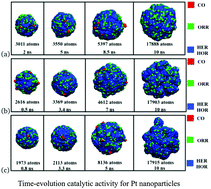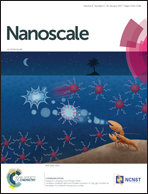Predicting the role of seed morphology in the evolution of anisotropic nanocatalysts†
Abstract
Controlling the structure of nanocrystals is an effective way to tune their properties and improve performance in a wide variety of applications. However, the atomic pathways for achieving this goal are difficult to identify and exercise, due to competing kinetic and thermodynamic influences during formation. In particular, an understanding of how symmetry, and symmetry breaking, determine nanocrystal morphology would significantly advance our ability to produce nanomaterials with prescribed functions. In this study we present results of a detailed computational study into the atomic structure of platinum nanoparticles at early growth stages of formation, as a function of temperature and atomic deposition rates. We investigate the impact of different types of crystalline seeds and characterize the emergent structures via simulated High Resolution Transmission Electron Microscopy (HRTEM) images. We find that the choice of initial seed is an important driver for symmetry breaking, due to a combination of atomic deposition and etching on different seed facets. A mix of low index facets causes the formation of important surface defects, in addition to the absorption/adsorption of single atoms, which can be correlated with different catalytic reactions as the process perpetuates. These findings provide new insights into nanocrystal shape-control mechanisms and suggest new opportunities for future design of this important class of nanomaterials.



 Please wait while we load your content...
Please wait while we load your content...